Table of contents
Maple syrup is used to sweeten breakfast dishes and desserts, but is also used in salty, savory dishes. Since maple syrup is boiled down during production, it is not a raw food product. However, it is available in organic quality.
Use in cooking
Maple syrup is a boiled sap obtained from various types of maple ( Acer spp . ), but mainly from sugar maple ( Acer saccharum ). 1 The color of the vegan syrup ranges from golden to amber to dark brown. Several factors affect the color and flavor of maple syrup, such as chemical composition, season, production location and method, filtering, packaging conditions, and environmental conditions. Although the predominant flavor is sweet, maple syrup can range from a light, sweet but otherwise almost tasteless substance to a very strong, intense, tart flavor. In general, light syrup contains less flavor than dark syrup and is therefore milder. Most syrups used for cooking are medium in color and have a moderate to strong maple-caramel flavor. 2,3
This natural sweetener is an integral part of North American cuisine (Canada, USA). Pancakes served with maple syrup and bacon baked with maple syrup are particularly famous (vegan possible). Maple syrup also tastes excellent poured over vegan French toast and waffles with fruit (e.g.blueberries , strawberries , bananas ). It sweetens all kinds of pastries (e.g. banana bread with mango and ginger ) and desserts such as ice cream, cakes, muffins, cookies (e.g. flourless cinnamon stars with dried apples and walnuts ) and tarts (e.g. apricot cream tart ). It can also be used to sweeten homemade nut muesli (e.g. with hazelnuts , pecans , almonds , oat flakes , chia seeds , cinnamon orvanilla ), porridge and drinks such as tea, vegan milkshakes and lemonade. Basically, maple syrup can be used as a sweetener anywhere you would normally use sugar ( granulated sugar , brown sugar ) or honey .
Maple syrup is not only suitable for sweetening, it can also add a tasty note to savory and salty dishes. It is particularly good in marinades, sauces, spreads and dressings - together with white wine vinegar , apple cider vinegar or orange juice in autumn salads such as beetroot , endive with apples and walnuts or radicchio with pears . We recommend potatoes , pumpkin or carrots from the oven glazed with maple syrup - herbs such as rosemary or thyme go wonderfully with them. Maple syrup can also be used to prepare a spicy-sweet pasta with cherry tomatoes , spinach , garlic and chili .
Homemade preparation
How do you make your own maple syrup? Sap for making maple syrup can be extracted not only from sugar maple ( Acer saccharum ), but also from other maple trees such as Norway maple ( Acer platanoides ). If you have your own Norway maple in your garden with a trunk at least 25 cm in diameter, you can make your own maple syrup between February and April. A large tree produces around 40 liters of sap during the harvest season, which can be thickened to make one liter of syrup. 4
To tap sap, you need to drill a hole in the tree trunk (at a downward angle). It is best to do this on the side that receives the most light during the day. The drilling point should be 30-120 cm from the ground, e.g. below a thick branch or above a large root. The hole must cover the tap pipe and be at least 1.5 cm deeper. The liquid coming out of the tap pipe is led directly or with a hose into a collecting vessel (e.g. a drinks bottle tied to the trunk), which is covered to protect against rain and insects. The sap in the collecting vessel is emptied daily into a sealable collecting container (capacity approx. 40 l). After the harvest, the tap point must be closed well (e.g. with a piece of wood). The liquid is thickened in a large saucepan over heat until it has a syrupy consistency. Finally, the maple syrup is filled into sterilized glass bottles. 4
Note: As soon as the tapped sap turns dark in color, the season is coming to an end. Give the maple syrup tree a break next year so that you do not impair its growth. The following year you can harvest maple sap again. 4
Vegan recipe for rocket salad with maple syrup dressing
Ingredients (for 2 people): 100 g rocket , 2 oranges , 50 g walnuts, 25 g pomegranate seeds , 2 tbsp balsamic vinegar (white) , 1 tbsp rapeseed oil , 1 tbsp maple syrup (organic), ½ tsp lemon juice , some salt andpepper .
Preparation: Rinse the rocket, spin dry and arrange on two plates. Peel the oranges, cut horizontally into thin slices (or rings) and spread on the rocket salad. Sprinkle the walnuts and pomegranate seeds on top. For the vegan salad dressing, mix the vinegar, oil, maple syrup and lemon juice. Season with salt and pepper and drizzle over the salad.
Vegan recipes with maple syrup can be found under the note: " Recipes that have the most of this ingredient ".
| Not only vegans or vegetarians should read this: Vegans often eat unhealthily. Avoidable nutritional mistakes . |
Purchasing - Storage
Maple syrup is available in most supermarkets (e.g. Coop , Migros , Denner , Volg , Spar , Aldi , Lidl , Rewe , Edeka , Hofer , Billa ) and organic supermarkets (e.g. Denn's Biomarkt , Alnatura ), in organic quality, all year round.
The availability of maple syrup varies depending on the size of the store, catchment area, etc. Our recorded food prices for the DA-CH countries can be found above under the ingredient image - and by clicking you can see their development at different suppliers.
Attention: "Real maple-flavored syrup" is not real maple syrup. It is a product diluted with sugar cane syrup. 5 To avoid adulterated maple syrup, it is best to choose organic products.
Storage tips
It is best to store maple syrup in a cool, dark place. This way it will last for years. Once the bottle has been opened, it should be kept in the refrigerator.
Close the bottle quickly and tightly after opening, as naturally occurring yeasts can enter the opened bottle through contact with air and form a thin, white layer on the maple syrup. Remove the top layer by pouring it off quickly.
Ingredients - Nutritional values - Calories
Maple syrup is relatively high in calories with 260 kcal per 100 g. It contains 67 g/100 g of carbohydrates, the majority of which (60 g) is sugar. The protein content is low at 0.04 g/100 g and fat is also almost non-existent at 0.06 g/100 g. 6 The following are three notable maple syrup nutrients.
Maple syrup is rich in manganese , with 2.9 mg/100g (145% of the daily requirement). Dried stevia leaves (2.9 mg/100g) contain a similar amount, while other natural sweeteners such as honey (0.08 mg/100g), corn syrup (0.09 mg/100g), date syrup (0.1 mg/100g), rice syrup (0.1 mg/100g) and apple syrup (0.31 mg/100g) contain much less. Even more manganese can be found in cloves (60 mg/100g), although only small amounts are used. 6
Does maple syrup contain vitamins?Riboflavin (vitamin B 2 ) is also present in abundance at 1.3 mg/100g (91% of daily requirement). At 0.46 mg/100g, the riboflavin content of the sweetener carob powder is closest to that of maple syrup. Yeast extract contains significantly more at 18 mg/100g. 6
Maple syrup also contains zinc (1.5 mg/100g; 15% of the daily requirement). Dried stevia leaves have a comparable content (1.3 mg/100g). The zinc content of apple syrup (0.27 mg/100g), honey (0.22 mg/100g), coconut blossom sugar (0.2 mg/100g) and date syrup (0.16 mg/100g) is lower. Wheat germ contains eight times the nutrient at 12 mg/100g. 6
Maple syrup consists largely of sugar (mainly sucrose; little glucose and fructose) and water. It also contains secondary plant substances such as phenols, organic acids (malic acid, fumaric acid) and pyrazines. Compounds such as enolic, viscous oil and 5′-inosine monophosphate are responsible for its special taste and smell. 7 Microbial contamination of the maple sap, which changes over the course of the season, also affects the taste and color of the syrup. The origin also plays an important role in the chemical composition. 1
The complete ingredients of maple syrup, the coverage of the daily requirement and comparison values with other ingredients can be found in our nutrient tables. In the article Nutrients explained you will get a detailed insight into the topic.
Health Effects
Is maple syrup healthy? Maple syrup consists of sugars (mainly sucrose), trace amounts of organic acids, free amino acids, minerals and phenols. These trace components contribute to potential health benefits over granulated sugar . 1,2
Current scientific evidence suggests that phenolic compounds play a key role in the body's defenses by protecting it from damage caused by reactive oxygen species, which are known to be involved in the development of various cardiovascular, oncological, autoimmune and degenerative diseases. Phenols have antioxidant, antimutagenic, anti-inflammatory and anti-cancer effects. 1,2
Due to its high concentration of antioxidants and anti-aging compounds, consumption of maple syrup can play a positive role in protecting the skin and improving its appearance. 2
Excessive consumption of refined sugar is considered to be one of the main reasons for the global increase in obesity, type 2 diabetes and other metabolic disorders. Maple syrup, as well as other natural sweeteners (e.g. honey , agave syrup ), are often touted as an alternative to granulated sugar because they have a lower glycemic index (GI) and higher nutritional value. According to the United States Department of Agriculture, sugar has a glycemic index of 65, while maple syrup has a glycemic index of 54. 2 Note: Not all natural sweeteners are good sugar alternatives, for example, corn syrup and rice syrup have a very high GI. 1,2
Dangers - Intolerances - Side effects
Is maple syrup unhealthy? Carbohydrates, primarily sugar, are the main component of maple syrup. Excessive carbohydrate consumption is linked to diseases such as diabetes and obesity. 2 Maple syrup should therefore only be consumed in moderation.
Like many other sweeteners, maple syrup is harmful to teeth. Moderate consumption helps here too. You should also rinse your mouth with water after eating sweet foods and brush your teeth regularly.
Does maple syrup contain fructose? Although the fructose content in maple syrup is low, it is still unsuitable for people with fructose intolerance.
Ecological footprint - animal welfare
According to a study by the AGECO group in 2021, a can of maple syrup causes around 600 g of greenhouse gas emissions, which is equivalent to a 1.7 km car journey. The largest part of the ecological footprint is attributable to the syrup itself. Packaging only accounts for 15% of the footprint, transport only 5%. More than half of the CO 2 footprint is caused by processing. Today, 50% of syrup is produced using oil-fired evaporators, which generate significant greenhouse gas emissions when burned to generate heat. Evaporators heated with wood pellets enable a lower CO 2 footprint for the production of maple syrup. Electric evaporators produce even fewer greenhouse gas emissions. 8
Trees, including maple trees, are considered carbon sinks. This means that the amount of CO 2 released by the decomposition of dead wood is less than that which trees absorb during growth and store in their trunks, branches and roots. According to a study conducted by AGECO in 2016, the maple trees used to produce maple syrup in Quebec (Canada) store 962,000 tonnes of CO 2 per year. According to this calculation, the trees store 8 times more carbon than the production of maple syrup emits. 8 The transport costs incurred when importing foreign maple syrup (e.g. from Canada, China) to Europe are not taken into account here.
We were unable to find any concrete figures for the CO 2 footprint for maple syrup. The Danish climate database Concito (2024) shows data for granulated sugar : 2.41 kg CO 2 eq/kg, brown sugar : 2.24 kg CO 2 eq/kg, syrup: 1.42 kg CO 2 eq/kg and honey : 0.79 kg CO 2 eq/kg. 10 However, these figures differ from those from Germany: according to the Institute for Energy and Environmental Research Heidelberg ( ifeu ), honey in a jar has a CO 2 footprint of 2 kg CO 2 eq/kg, organic beet sugar 0.5 kg CO 2 eq/kg and organic cane sugar 0.9 kg CO 2 eq/kg. 11
Organic maple syrup is preferable because organic production avoids the use of chemical-synthetic pesticides and fertilizers that are harmful to health and the environment. In conventional cultivation, bleach is also used to keep the boreholes open and pumps are used to create a vacuum in the tree and achieve a higher yield. 9
Worldwide occurrence - cultivation
Where does maple syrup come from? Various legends describe the discovery of sweet maple sap by Native Americans. The most likely is that they observed animals cutting holes or cracks in tree branches, or sap leaking out after a branch was broken off by snow or wind. Sap leaks out of these small wounds in the spring, forming small drops that concentrate the sun and wind. Native Americans recognized this and collected maple sap by cutting slits in the trunks of maple trees and collecting it with skins, hollowed-out wooden vessels, or clay pots. By boiling it, they concentrated it into a dark and strong-tasting sugar. At certain times of the year, maple sugar could make up a significant portion of the calorie intake. Early colonists in New England took over maple syrup production - imported sugar was expensive and no other agricultural activity was possible at that time of year. 3
According to Agriculture and Agri-Food Canada, Canada is the world's largest producer of maple products. In 2022, Canada produced approximately 65.8 million liters of maple syrup and the United States produced approximately 20.2 million liters. Quebec is the province with the highest maple syrup production in Canada, leaving the second largest producing province, New Brunswick, far behind. New Brunswick's production level is equivalent to that of Vermont in the United States, by far the largest maple syrup producer in the country, followed by New York. 1,2
Maple syrup is not only appreciated in North America. Recently, interest in this product has spread to other regions of the world, such as Europe and Japan, due to the demand for natural sweeteners. 1
Industrial production
Under suitable conditions, a sweet sap can be extracted from most maple species ( Acer spp.). The most important producing species are sugar maple ( Acer saccharum ; 70 %) and red maple ( Acer rubrum ; 29 %). Silver maple ( Acer saccharinum ) and black maple ( Acer nigrum ) are also considered to be maple sap-producing species, but they are rarely used. 1,3
How is maple syrup made? Maple trees accumulate starch as they grow. During the spring thaw, this is converted into sugar and mixes with the water absorbed by tree roots to form maple sap. This sweet, watery xylem sap flows through the tree between February and April. If weather conditions permit, it can be collected during this time. To do this, holes are drilled into maple tree trunks into which taps are inserted. Pressure built up by the freeze-thaw cycle causes the sap to flow from the trunks of the maple trees through taps and pipes into buckets. 1
How is maple syrup made? After collection, the maple sap is concentrated to make maple syrup. The two main concentration processes used to make maple syrup are evaporation by heating and reverse osmosis followed by heating. This concentrates the sugar content to 66% or 66-67 Brix, resulting in a thick, sweet syrup. 1,2,3 To make one liter of maple syrup, you need about 40 liters of sap (2-3% sugar content). 1
Maple syrup comes in different qualities that vary in color, composition and flavor. Maple sap collected early in the season produces light-colored syrup, while syrup made later in warmer weather is dark. 2
Further information
Maple syrup quality is assessed in the United States and Canada using classification schemes that use typical standards for assessing price, including the intensity of the product's color (lighter products tend to be more expensive). At the beginning of the harvest, the syrup is clear and has a slight sweetness. As the season progresses, the syrup takes on a darker color and has distinct aromatic notes. 1
Canadian maple syrup is divided into two grades: Canada Grade A and Canada Processing Grade. Canada Grade A is further divided into four color grades, including a reference to taste: Golden, Delicate Taste, Amber, Rich Taste, Dark, Robust Taste, and Very Dark, Strong Taste. Grade A maple syrup must meet a certain standard (no discoloration or cloudiness, free of sediment, characteristic maple aroma, no uncharacteristic odors or flavors). Canada Processing Grade has no color grades. It is often used for large-scale, commercial applications. 1
Alternative names
In English, maple syrup is called maple syrup.

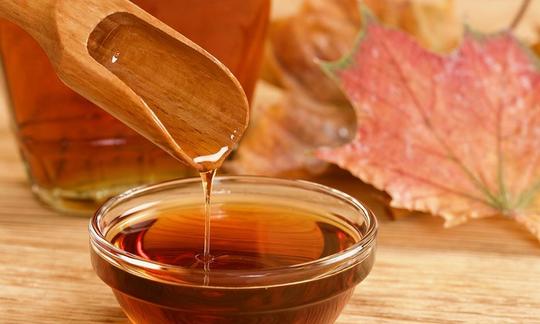

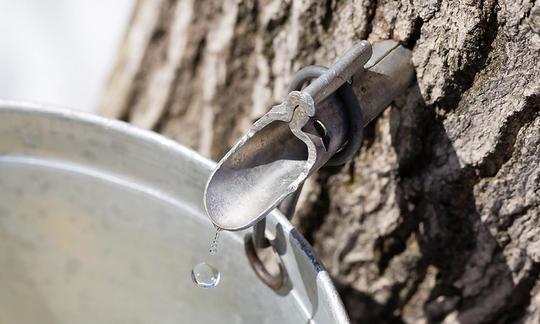

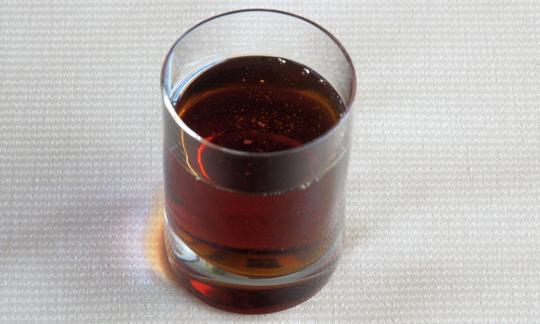

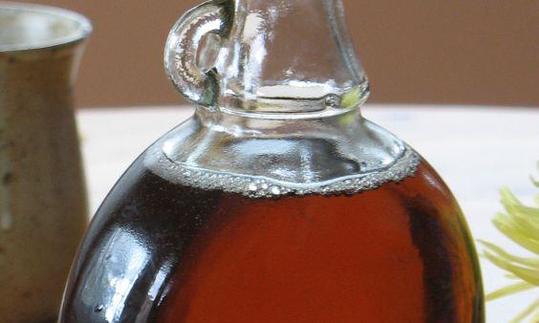

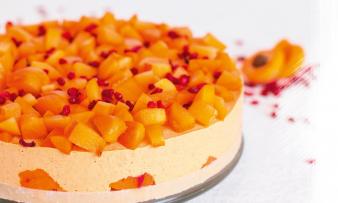
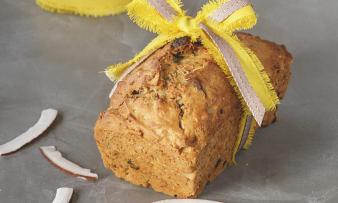
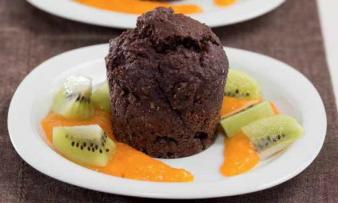

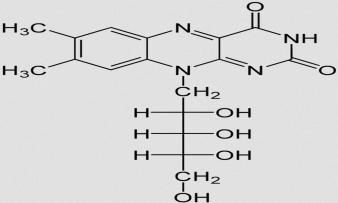
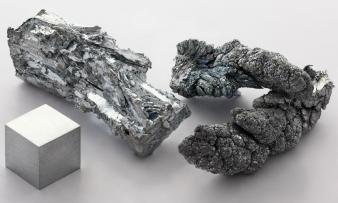


Comments